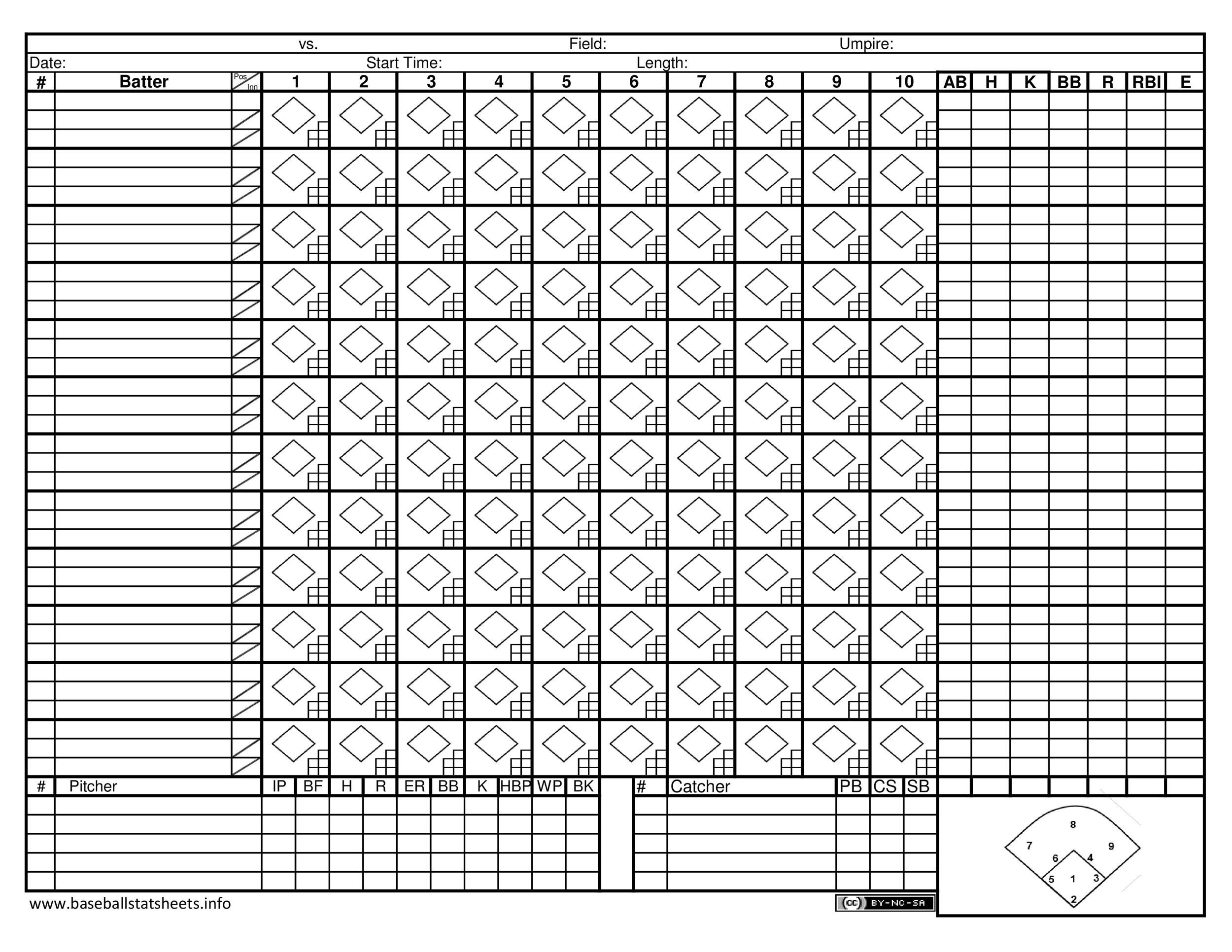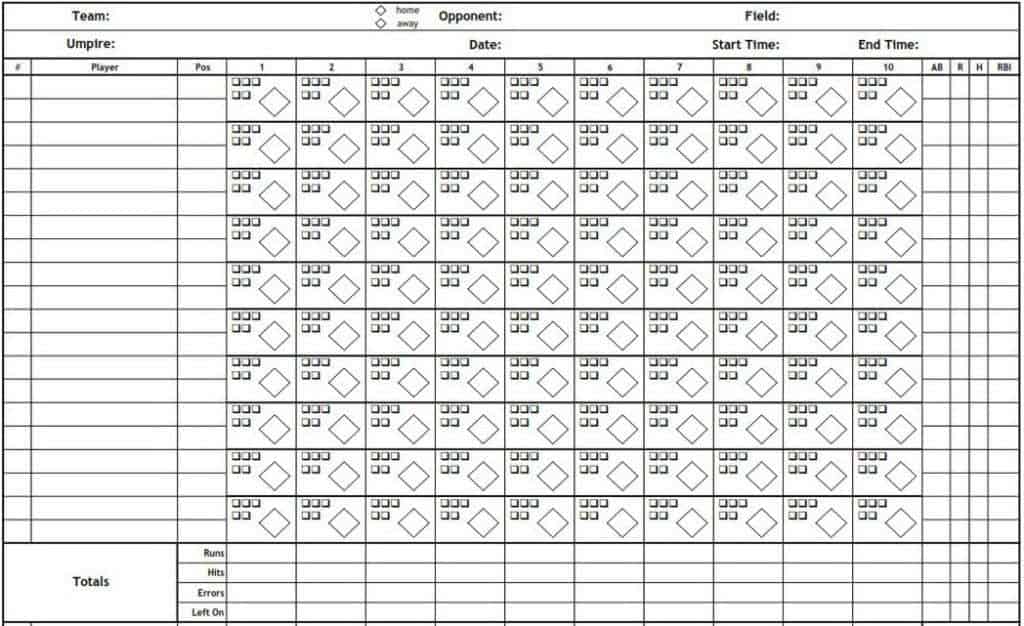Delve into the world of baseball printable score sheets, a practical and efficient way to keep track of game progress. In this engaging intro, we will explore the purpose, benefits, and various components of these score sheets, providing you with valuable insights into their usage.
We will also discuss different formats, tips for accurate recording, and advanced features that can enhance your scorekeeping experience. Additionally, we’ll touch upon the importance of accuracy and consistency in scorekeeping, as well as alternative methods and resources for finding or creating personalized score sheets.
Get ready to level up your baseball scorekeeping skills!
Introduction to Baseball Printable Score Sheet
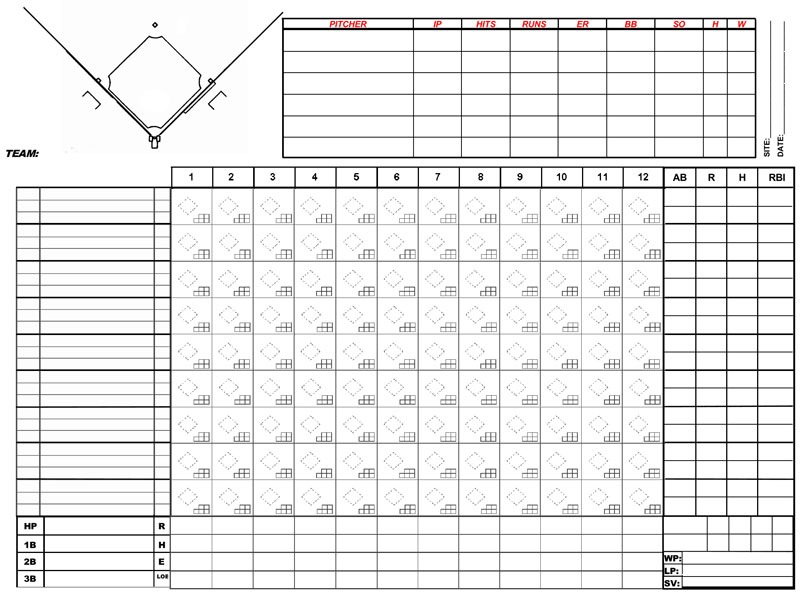
A baseball printable score sheet is a document that allows individuals to keep track of the score and statistics of a baseball game. It provides a structured format for recording important information such as runs, hits, errors, and player performance.Using
a printable score sheet for baseball games offers several benefits. Firstly, it helps maintain an accurate record of the game, allowing players, coaches, and fans to review and analyze the performance of the teams and players involved. It serves as a valuable tool for scouting, player development, and strategy refinement.Furthermore,
a printable score sheet aids in communication and documentation. It allows for easy sharing of game information with team members, coaches, and league officials. It also serves as a historical record of the game, preserving the details and highlights for future reference.There
Are you interested in 3D printing and knives? If so, you might want to check out the 3D printable butterfly knife . This unique and customizable knife design can be printed using a 3D printer. It’s a great project for knife enthusiasts or anyone looking to create their own functional knife.
With the help of the provided link, you can find the necessary files and instructions to print your very own butterfly knife. Get creative and start printing!
are different types of baseball printable score sheets available, depending on the level of detail and complexity desired. Some score sheets are designed for recreational or amateur games, while others are tailored for professional or advanced play. These score sheets may include additional sections for pitch counts, substitutions, and other advanced statistics.
Examples of Different Types of Baseball Printable Score Sheets
- Basic Score Sheet: This type of score sheet includes the essential information such as runs, hits, errors, and player names. It is commonly used for casual or amateur games.
- Advanced Score Sheet: Designed for more detailed record-keeping, this score sheet includes additional sections for pitch counts, substitutions, and other advanced statistics.
- Team Score Sheet: This score sheet focuses on specific team statistics, such as batting averages, on-base percentages, and fielding percentages. It allows for a comprehensive analysis of team performance.
- Individual Player Score Sheet: This score sheet is centered around individual player performance, recording their at-bats, hits, walks, strikeouts, and other relevant statistics. It is especially useful for player evaluation and development.
Overall, a baseball printable score sheet is a valuable tool for recording, analyzing, and communicating the details of a baseball game. It provides a structured format for tracking important information and contributes to the overall enjoyment and understanding of the sport.
Components of a Baseball Printable Score Sheet
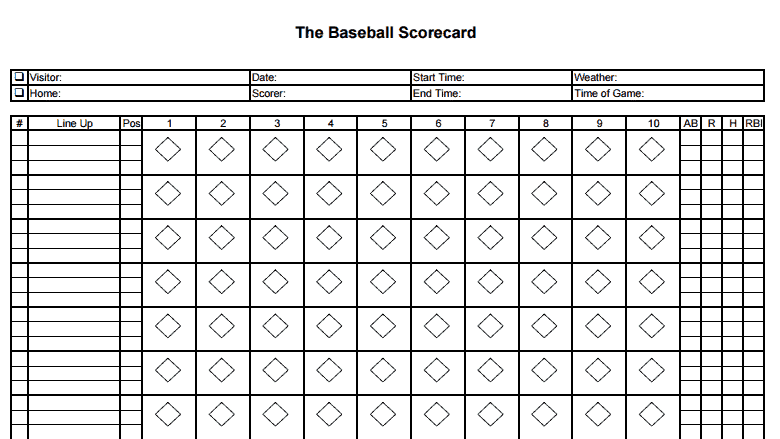
A baseball printable score sheet is a document used to keep track of the game’s progress and record important information. It consists of several key components that help organize and display the data effectively.
Player Names and Positions
- The score sheet includes a section to write down the names of all players participating in the game. This allows for easy identification of each player’s performance.
- Next to each player’s name, their respective positions are noted. This helps track defensive plays and provides a comprehensive overview of the game.
Innings
- The score sheet is divided into columns representing each inning of the game. This allows for the recording of runs, hits, and other statistical information on a per-inning basis.
- Each inning column is further divided into smaller sections to record the individual performances of the players.
Scoring Symbols
- To record the game’s progress accurately, scoring symbols are used on the score sheet. These symbols represent various actions and outcomes during the game.
- Common scoring symbols include circles for base hits, squares for outs, numbers for runs scored, and dashes for no action.
- These symbols help provide a visual representation of the game’s events and make it easier to interpret the score sheet.
Importance of Accurate Recording
Accurately recording information on the score sheet is crucial for several reasons:
- It allows for a comprehensive analysis of the game, including individual player performances and team statistics.
- The score sheet serves as a historical record of the game, providing valuable data for future reference and analysis.
- Accurate recording ensures fairness and transparency in scoring and evaluation.
- It helps identify areas of improvement and strategize for future games.
Tips and Best Practices
When filling out a baseball printable score sheet, consider the following tips and best practices:
- Use clear and legible handwriting to ensure the information can be easily read and understood.
- Double-check the accuracy of the recorded data to avoid errors in calculations and analysis.
- Stay focused and attentive during the game to ensure all important events are properly recorded.
- Consult the official scoring rules and guidelines to ensure consistency in the use of scoring symbols.
- Regularly update the score sheet throughout the game to maintain an up-to-date record of the game’s progress.
Different Formats of Baseball Printable Score Sheets

Baseball printable score sheets are available in various formats to cater to different preferences and requirements. These formats include traditional paper-based sheets and digital/printable templates. Each format has its own advantages and disadvantages.
Traditional Paper-based Sheets
Traditional paper-based score sheets have been used for many years and are still popular among baseball enthusiasts. These sheets are typically printed on paper and filled out manually during the game. Here are some advantages and disadvantages of traditional paper-based score sheets:
- Advantages:
- Simple and straightforward to use
- No need for any technological device or software
- Can be easily customized or modified
- Disadvantages:
- Can be time-consuming to fill out manually
- Prone to errors and illegible handwriting
- Difficult to share or distribute digitally
Digital/Printable Templates
With the advancement of technology, digital/printable score sheet templates have become popular. These templates can be downloaded and printed, or filled out digitally using software or online tools. Here are some advantages and disadvantages of digital/printable score sheet templates:
- Advantages:
- Quick and easy to fill out
- Can be saved, shared, and distributed electronically
- Eliminates the possibility of illegible handwriting
- Disadvantages:
- Requires access to a computer or mobile device
- May have a learning curve for using software or online tools
- Less customizable compared to traditional paper-based sheets
There are various websites and platforms that offer popular baseball printable score sheet templates. Some examples include:
[Website 1]
Looking for a fun and practical way to save money? Try the 52 week money challenge printable . This printable template provides a simple and effective method to save money over the course of a year. Each week, you can mark off the amount you’ve saved and watch your savings grow.
Whether you’re saving for a specific goal or just want to build up your emergency fund, this challenge can help you stay motivated and accountable. Start the challenge today and see how much you can save!
This website provides a collection of printable score sheet templates for different sports, including baseball. They offer both traditional paper-based sheets and digital/printable templates.
[Website 2]
Another website that offers customizable baseball printable score sheet templates. Users can choose from different designs and formats according to their preferences.In conclusion, baseball printable score sheets are available in different formats, including traditional paper-based sheets and digital/printable templates. Each format has its own advantages and disadvantages.
It is important to choose the format that best suits your needs and preferences.
How to Use a Baseball Printable Score Sheet
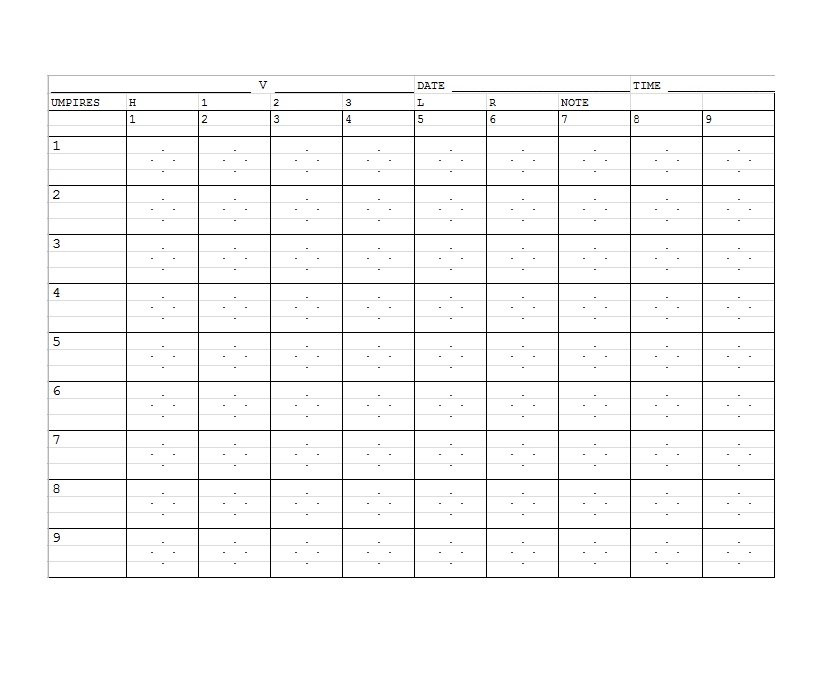
Using a baseball printable score sheet during a game can help you keep track of the progress and statistics of the game. Here is a step-by-step process on how to effectively use a baseball printable score sheet:
Step 1: Familiarize Yourself with the Score Sheet
Before the game starts, take some time to familiarize yourself with the layout and components of the score sheet. Make sure you understand the symbols and abbreviations used for different actions and statistics.
Step 2: Assign Roles
Assign someone to be the scorekeeper. The scorekeeper is responsible for recording all the actions and statistics of the game. It is important to choose someone who is attentive and knowledgeable about baseball.
Step 3: Record the Lineup
Start by recording the lineup of both teams on the score sheet. Write down the names of the players in their respective batting order. You can also include their positions in the field.
Step 4: Track the Game Progress
As the game progresses, the scorekeeper should record all the actions and events that occur. This includes balls, strikes, hits, runs, outs, and other important actions. Use the symbols and abbreviations provided on the score sheet to accurately record each action.
Step 5: Calculate Statistics
The score sheet also allows you to calculate various statistics during the game. Keep track of batting averages, earned run averages, on-base percentages, and other relevant statistics. Use the formulas provided on the score sheet to calculate these statistics accurately.
Step 6: Review and Analyze
After the game, review the score sheet and analyze the statistics recorded. This can help you identify strengths and weaknesses, evaluate player performances, and make strategic decisions for future games.
Step 7: Maintain Accuracy
It is crucial to maintain accuracy when using a baseball printable score sheet. Pay attention to every action and record them correctly on the score sheet. Double-check the scores, statistics, and other recorded information to ensure accuracy.Using these steps, you can effectively use a baseball printable score sheet to track game progress and statistics.
The scorekeeper plays a crucial role in ensuring accurate recording of actions and statistics. With practice and attention to detail, you can become proficient in using a score sheet to enhance your baseball game experience.
Advanced Features and Customization Options
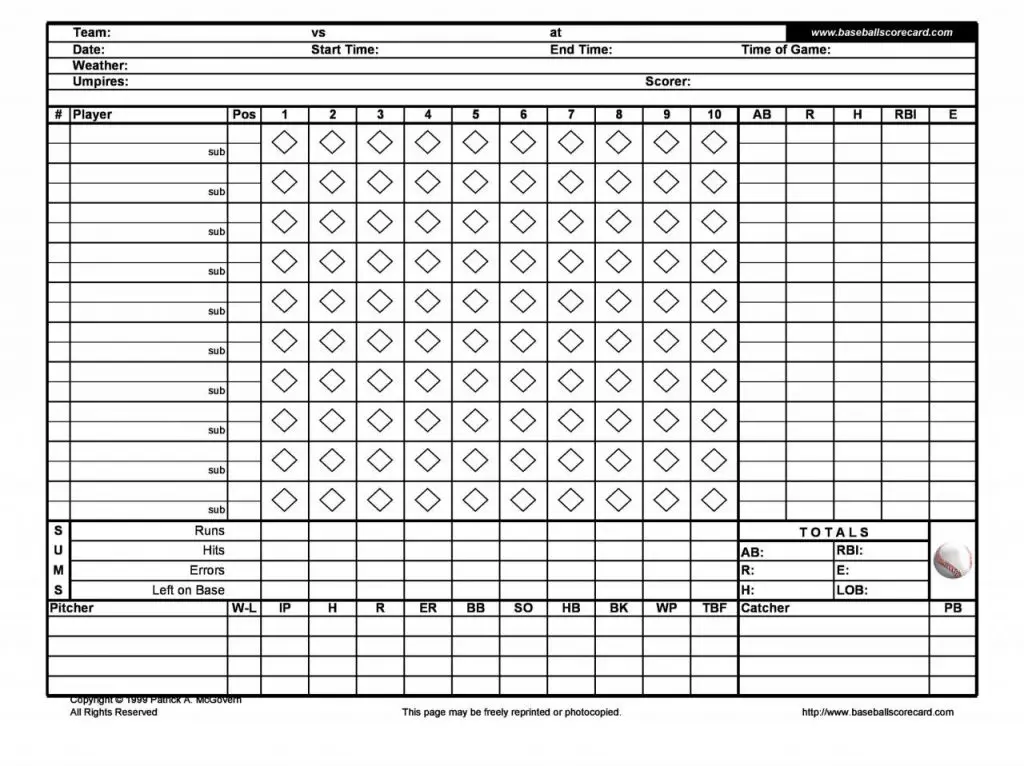
Baseball printable score sheets offer a range of advanced features and customization options that can enhance the scorekeeping experience and provide additional insights. These features allow scorekeepers to personalize their score sheets and tailor them to their specific needs. Here are some examples and suggestions for utilizing these advanced features and customizing a score sheet:
1. Customizable Field Layout
Some baseball printable score sheets allow users to customize the layout of the field. This feature is especially useful for scorekeepers who prefer a different arrangement or organization of the player positions and the diamond. By customizing the field layout, scorekeepers can easily track the movement of players and record defensive plays accurately.
2. Pitch Tracking
Advanced score sheets may include a pitch tracking feature that allows scorekeepers to record the type and location of each pitch thrown. This feature provides valuable insights into the pitching strategy and helps analyze the effectiveness of different pitch types in different situations.
Scorekeepers can use symbols or abbreviations to denote pitch types and mark the location of each pitch on a designated grid.
3. Player Performance Analysis
Some score sheets provide space for scorekeepers to record additional statistics or notes about each player’s performance. This customization option allows scorekeepers to track individual player statistics, such as batting average, on-base percentage, or fielding percentage. By analyzing these statistics, scorekeepers can identify patterns, strengths, and weaknesses in player performance, which can be helpful for coaches, scouts, or team management.
4. Scoreboard Integration
Incorporating a scoreboard section into the score sheet allows scorekeepers to keep track of the game’s score continuously. This feature is particularly useful for scorekeepers who are responsible for updating the scoreboard during the game. By integrating the scoreboard into the score sheet, scorekeepers can have a comprehensive overview of the game’s progress and easily update the score as the game unfolds.
5. Notes and Observations
Score sheets with customization options often provide space for scorekeepers to write notes or observations about specific plays, strategies, or game events. This feature allows scorekeepers to capture important details that may not be reflected in the standard scoring system.
Scorekeepers can use this space to highlight exceptional plays, record coaching decisions, or analyze game-changing moments.
6. Team Logo and Colors
To add a personal touch, some score sheets allow scorekeepers to include their team’s logo and colors. By customizing the score sheet with team branding, scorekeepers can create a sense of identity and pride while keeping score. This feature is especially popular in youth leagues or recreational leagues where team spirit and camaraderie are emphasized.
7. Printable Summaries and Reports
Advanced score sheets may offer the option to generate printable summaries or reports based on the recorded data. These summaries can include game statistics, player performance analysis, or game summaries. This feature is beneficial for teams, coaches, or players who want a comprehensive overview of the game’s outcome and individual performances.
These are just a few examples of the advanced features and customization options available in some baseball printable score sheets. By utilizing these features, scorekeepers can enhance the scorekeeping experience, gain deeper insights into the game, and create personalized records that reflect their unique perspective.
Importance of Accuracy and Consistency in Scorekeeping
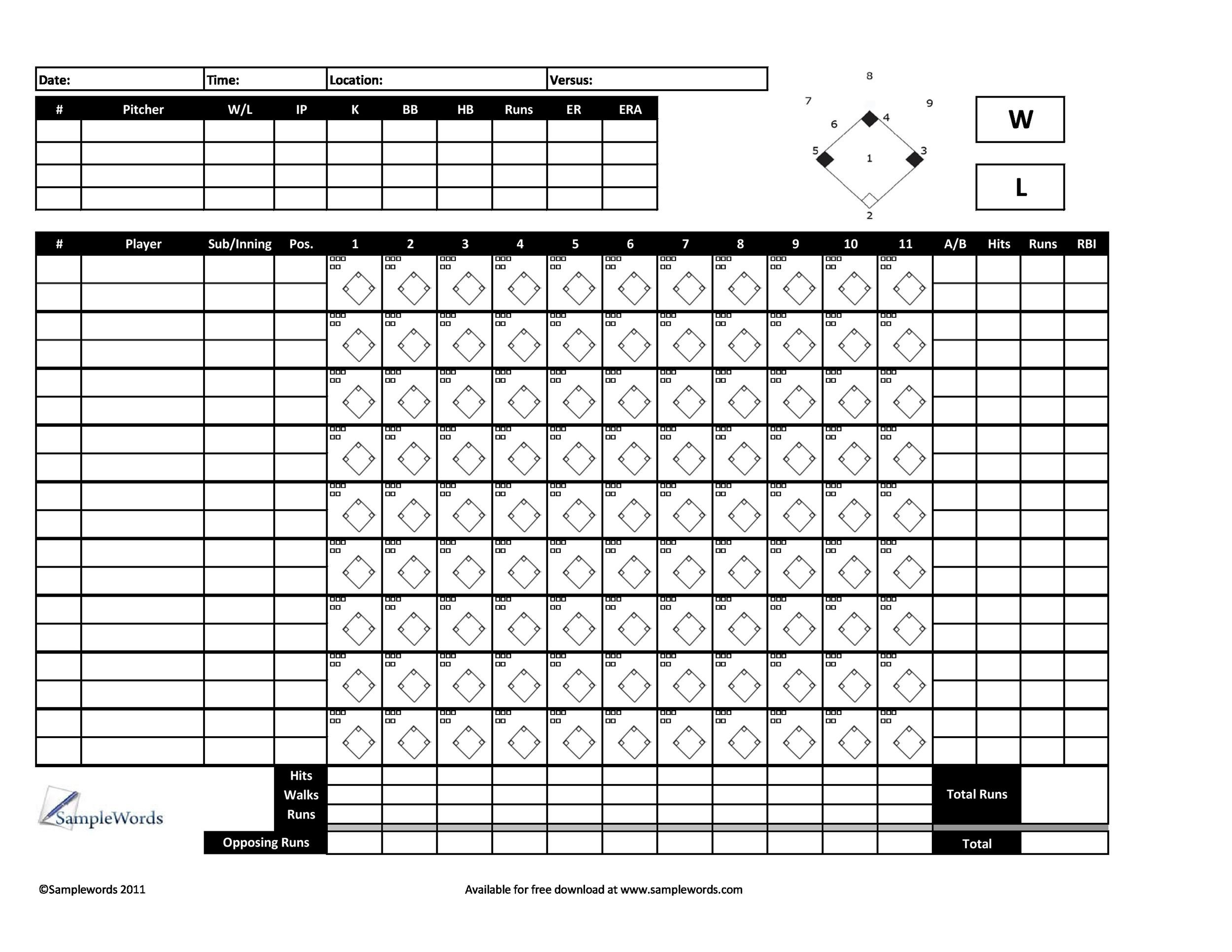
Accurate and consistent scorekeeping is crucial in baseball as it serves as the official record of the game. It provides a detailed account of each play, including runs scored, outs made, and other key statistics. This information is used by teams, coaches, and analysts for performance analysis, strategy development, and player evaluation.
In addition, accurate scorekeeping ensures fairness and integrity in the game by providing an objective record of the events that occurred.Errors or discrepancies in the score sheet can have significant implications. Inaccurate or inconsistent scorekeeping can lead to incorrect game outcomes, unfair player assessments, and flawed statistical analysis.
It can also impact the overall integrity of the game, causing confusion and disputes among teams and fans. Furthermore, errors in scorekeeping can result in incorrect historical records and statistics, which are important for tracking player achievements and comparing performance across different eras.To
ensure accuracy and consistency in scorekeeping, here are some tips and techniques:
1. Familiarize Yourself with the Official Scorekeeping Rules
Before scoring a game, it is essential to have a thorough understanding of the official scorekeeping rules. Familiarize yourself with the scoring symbols, abbreviations, and terminology used in baseball. This will help you accurately record each play and assign the appropriate statistics to players.
2. Pay Close Attention to the Game
Stay focused and attentive throughout the game to avoid missing any crucial plays or details. It is important to watch each pitch, hit, and fielding play carefully to accurately record the events. Avoid distractions and remain engaged in the game to ensure accurate scorekeeping.
3. Double-Check Your Entries
After recording each play, take the time to double-check your entries for accuracy. Review the score sheet regularly to identify any potential errors or discrepancies. This will help you catch and correct mistakes before they impact the final score or statistics.
4. Communicate with the Official Scorekeeper
If you are scoring a game as a fan or a secondary scorekeeper, it is advisable to communicate with the official scorekeeper. Clarify any doubts or uncertainties regarding the scoring rules and seek guidance if needed. Maintaining open communication can help ensure consistency in scorekeeping between different scorekeepers.
5. Use Technology and Scorekeeping Apps
In today’s digital age, there are various scorekeeping apps and software available that can assist in accurate and consistent scorekeeping. These tools often have built-in features that automatically calculate statistics and provide error-checking mechanisms. Utilizing such technology can help minimize human errors and enhance the accuracy of scorekeeping.By
prioritizing accuracy and consistency in scorekeeping, we can preserve the integrity of the game and provide reliable records for analysis and historical documentation. So, whether you are a scorekeeper, a coach, or a fan, remember the importance of accurate and consistent scorekeeping in baseball.
Resources for Finding and Creating Baseball Printable Score Sheets
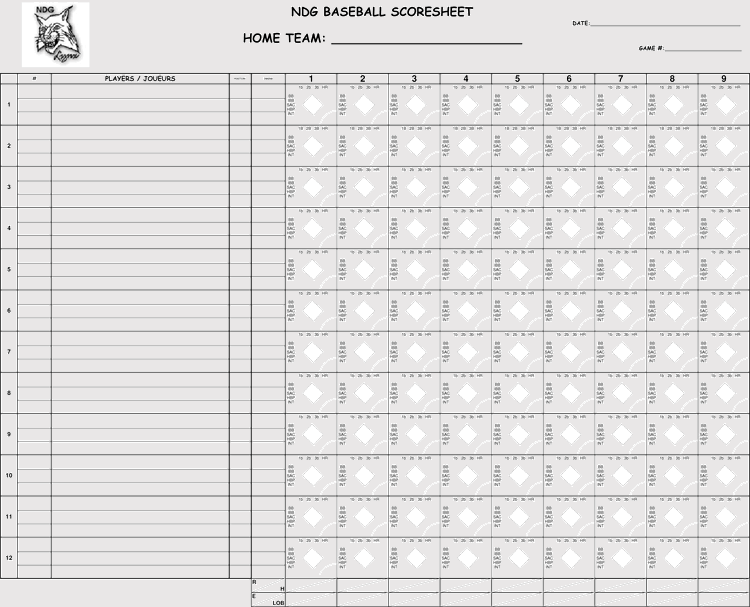
When it comes to finding and creating baseball printable score sheets, there are several options available. Whether you prefer pre-designed templates or want to create your own customized sheets, you can find the resources you need to keep score accurately and efficiently.
Pre-Designed Score Sheets, Baseball printable score sheet
If you’re looking for ready-made score sheets, there are websites and sources that offer a variety of templates to choose from. Some popular options include:
- 1. PrintYourBrackets.com – This website offers free downloadable baseball score sheets in PDF format. You can find different designs and formats to suit your preferences.
- 2. Vertex42.com – Vertex42 provides free printable baseball score sheets in Excel format. These sheets are customizable and can be filled out digitally or printed for manual scorekeeping.
- 3. BaseballScorecard.com – This website offers printable scorecards that are specifically designed for scorekeeping during baseball games. They provide both basic and advanced score sheets.
These websites are just a few examples, and you can explore more options based on your specific requirements.
Creating Customized Score Sheets
If you prefer to create your own personalized baseball score sheets, there are software programs and online tools available to assist you. These tools allow you to customize the layout, include specific fields, and add your team’s logo or branding.
Some popular options for creating customized score sheets include:
- 1. Microsoft Excel – Using Excel, you can design and format your own score sheets by inserting text boxes, tables, and formulas. This gives you complete control over the design and layout.
- 2. Google Sheets – Similar to Excel, Google Sheets offers the flexibility to create and customize score sheets. It also allows for easy collaboration and sharing with others.
- 3. Online Score Sheet Generators – There are various online tools available that allow you to generate customized baseball score sheets. These tools usually have pre-defined templates that you can modify to suit your needs.
By using these software programs and online tools, you can design score sheets that align with your specific requirements and preferences.
Tips for Designing and Creating Personalized Score Sheets
When designing and creating personalized baseball score sheets, consider the following tips:
- 1. Include all necessary fields: Make sure to include fields for recording player names, positions, at-bats, hits, runs, and other relevant information.
- 2. Use clear and legible fonts: Choose fonts that are easy to read, especially when the score sheets are filled out manually during fast-paced games.
- 3. Consider color coding: Utilize different colors to distinguish between home and away teams, highlight important plays, or indicate specific game events.
- 4. Test and revise: Before finalizing your score sheet design, print a few copies and test them during practice games. Make any necessary revisions based on usability and clarity.
Designing and creating personalized score sheets can enhance your scorekeeping experience and make it easier to track and analyze game data.
Alternative Scorekeeping Methods
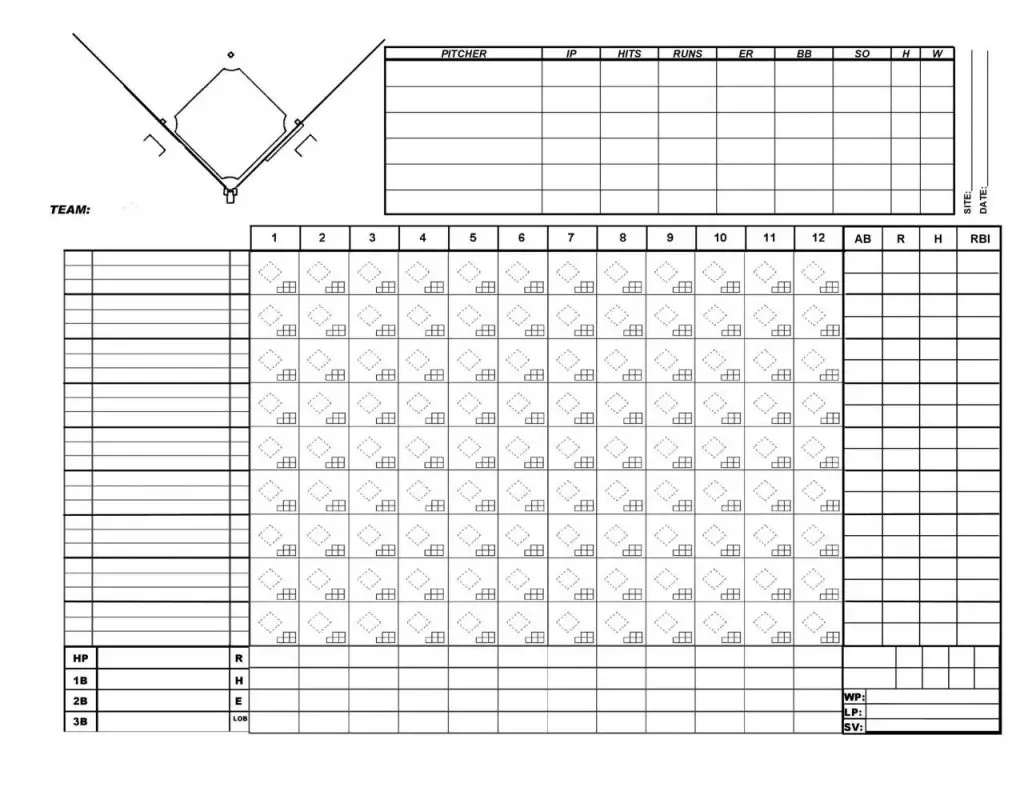
While printable score sheets have been a traditional and widely used method of scorekeeping in baseball, there are also alternative methods available, such as electronic scoring apps or software. These digital tools offer certain advantages and disadvantages compared to the traditional pen-and-paper approach.
Advantages of Electronic Scoring Apps and Software
- Efficiency: Electronic scoring apps and software allow for faster and more accurate scorekeeping. They eliminate the need for manual calculations and provide instant updates.
- Advanced Features: These digital tools often come with advanced features such as pitch tracking, player statistics, and game analysis. They provide a more comprehensive and detailed overview of the game.
- Accessibility: With electronic scoring apps and software, scorekeeping can be done on smartphones, tablets, or computers. This makes it more convenient and accessible for scorekeepers.
- Real-time Sharing: Some electronic scoring tools allow for real-time sharing of the game score and stats with coaches, players, and fans. This enhances the overall experience and engagement.
Disadvantages of Electronic Scoring Apps and Software
- Learning Curve: Using electronic scoring apps and software requires some initial learning and familiarization. Scorekeepers need to understand the functionalities and interface of the digital tool.
- Reliance on Technology: Electronic scorekeeping methods are dependent on technology and can be prone to technical issues or glitches. This can disrupt the scorekeeping process and affect the accuracy of the recorded data.
- Cost: Some electronic scoring apps and software may come with a cost, especially if they offer advanced features or premium versions. This can be a deterrent for scorekeepers on a tight budget.
Popular Electronic Scoring Tools
Here are some popular electronic scoring tools that are widely used and recommended:
- GameChanger: GameChanger is a comprehensive scoring app that offers real-time scoring, live game updates, and team management features.
- iScore Baseball: iScore Baseball is a versatile scoring app that allows for detailed scorekeeping, pitch tracking, and player statistics.
- Diamond Scheduler: Diamond Scheduler is a scheduling and scorekeeping software that offers a range of features for managing baseball games and tournaments.
- Rapsodo Baseball: Rapsodo Baseball is a cutting-edge technology that combines radar and camera systems to capture and analyze player performance data.
These tools provide different functionalities and cater to various needs. It’s important to explore and choose the one that best fits your requirements and preferences.
